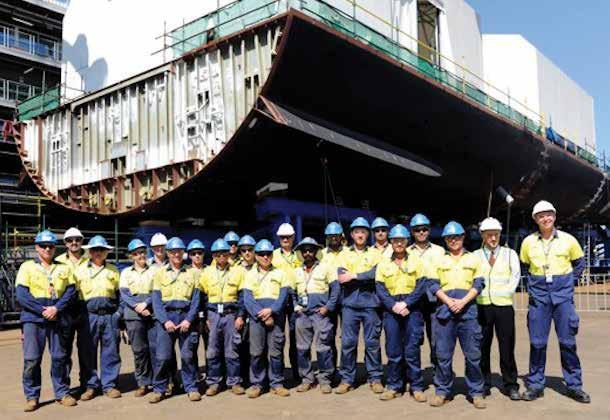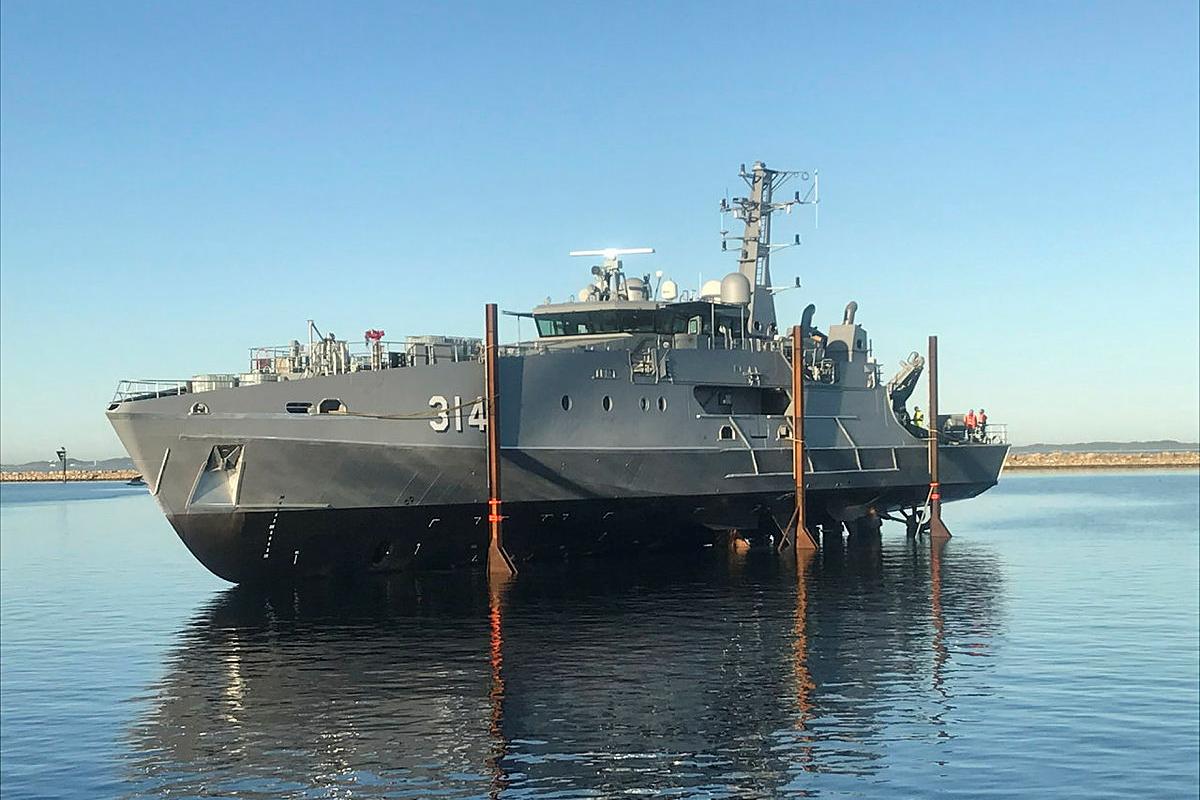- Author
- Editorial Staff
- Subjects
- Infrastructure and Facilities
- Tags
-
- RAN Ships
- None noted.
- Publication
- December 2021 edition of the Naval Historical Review (all rights reserved)
A number of well-intentioned Government initiatives are not necessarily known in the wider community. In the case of the Naval Shipbuilding College this is a pity, as this organisation has an important role to play in the delivery and maintenance of our future naval vessels. The following article seeks to address some of these shortcomings.
Background
In an absolute sense shipbuilding has been with us from the time indigenous people first took to the water in log and bark canoes, dependent upon their environment and the availability of materials. These skills were refined as they were passed from father to son. Nothing much changed over the centuries, except that slightly more sophisticated craft were adopted from interaction with the peoples of Papua.
It was not long after the first European settlement that a shipbuilding yard was established on the shores of Sydney Cove. It developed over time into a considerable industry, with slipways to allow ships to be taken out of the water during construction and subsequently for repairs.
The first graving dock to open was constructed by the entrepreneur Thomas Sutcliffe Mort in 1855. In 1871 Mort’s Dock had the distinction of building Governor Blackwall, the first vessel of all-iron construction. In 1919 the Sydney shipbuilder Poole & Steel established a second shipyard at Osborne in South Australia, allowing them to participate in the Commonwealth building program of E-class cargo ships. With a lack of following work, the yard was unable to survive and closed, with the Osborne site sold to the South Australian Government in 1937.
After a difficult inter-war period and suffering the effects of the Great Depression, renewed activity occurred during WWII with naval construction taking place around the country producing everything from destroyers, to corvettes and motor launches. Shipyards were also busy maintaining merchant tonnage and an American fleet of submarines based on both the east and west coasts.
At the height of wartime production various dockyards became major employers with, for example, Cockatoo Island Dockyard employing over 4,000 personnel at the end of WWI. In meeting its training requirements covering all trades up to 400 apprentices were still employed into the 1980s. Unfortunately, production was frequently interrupted by demarcation and other industrial disputes of a factionalised workforce.
At the end of WWII there were six recognised commercial shipbuilders: BHP Whyalla, State Dockyard Newcastle, Evans Deakin Brisbane, Cockatoo and Mort’s Dock in Sydney and Walkers in Maryborough. With a decline in post-war naval activity a commercial shipbuilding program was consolidated closer to the steel mills at Newcastle and Whyalla. As Asian economies developed the cost structure of Australian construction became uneconomic, leading to a rapid decline in demand. However, two local shipbuilders specialising in lightweight aluminium construction, one in Western Australia and the other in Tasmania, carved a remarkable niche in worldwide markets. Elsewhere shipbuilding largely depends upon Government stimulus supporting a level of localised naval construction.

While the Australian merchant and fishing fleets have diminished to almost negligible levels a naval construction program has been maintained. This has helped retain a localised skill set allowing for a level of construction and maintenance to the benefit of local industry, local workforce and follow-through economic benefits. With the Royal Australian Navy going through a regeneration phase the government has sought improvements to the industry and to formalise methods of procurement which includes local content, requiring a trained workforce.
Investment into the Future – Shipbuilding in South Australia and Western Australia
The Federal Government is investing up to $183 billion in establishing an Australian shipbuilding and sustainment enterprise, and for this to succeed, the enterprise requires well-planned and managed projects with a highly capable workforce. To help achieve this we now have two principal shipbuilding hubs, one at Osborne in South Australia and another at Henderson in Western Australia. At Osborne, the previous Australian Submarine Corporation responsible for the maintenance of the Collins class submarines and their life-of-type extension became part of BAE Systems Australia. It was also responsible for construction of the Hobart class air warfare destroyers. The first two of the Arafura class offshore patrol vessels were constructed here and nine Hunter class frigates are in the pipeline. On 16 September 2021 the Government also announced plans to build a future fleet of at least eight nuclear powered submarines in South Australia.
After a rationalisation of the shipbuilding industry the Henderson hub in Western Australia is now home to CIVMEC, a joint Singaporean-Australian company involved in construction, engineering and shipbuilding. They are building the remaining eight Arafura class offshore patrol vessels, with Austal Australia building 21 Guardian class and six Evolved Cape class patrol boats. The Henderson precinct also supports Anzac class frigates and Collins class submarines. It expects to be involved in the building of future mine warfare and hydrographic vessels, and Army water and landing craft.
The Naval Shipbuilding College
Importantly, in 2018 a Naval Shipbuilding College (NSC) was formed, also based at Osborne and co‑located with the major shipyard. The NSC was established to ensure an ongoing sovereign workforce for the Australian shipbuilding industry and to identify the training and education requirements for this industry. The Naval Shipbuilding College is managed by the Naval Shipbuilding Institute, a joint venture between Kellogg Brown and Root and Huntington Ingalls Industries – both American companies, the former specialising in science, technology and engineering and the latter is America’s largest military shipbuilding company.
Ian Irvine, the Chief Executive of the Naval Shipbuilding Institute, outlined the role of the Naval Shipbuilding College in a keynote address at the PACIFIC 2019 Maritime Exposition. Mr Irvine provided the following commentary.
Mission and Vision of the College
The mission of the Naval Shipbuilding College is to lead the creation and sustainment of the enterprise that identifies, attracts and skills multi-generational sovereign capability for naval shipbuilding.
The Vision that the College has is that all stakeholders know that Australia has the shipbuilding capability to meet the Naval Shipbuilding Plan. The College has been established to serve a number of stakeholder groups.
- Firstly, the Commonwealth – the Department of Defence. To lead the creation and sustainment of the Enterprise that identifies, attracts and skills multi-generational sovereign capability for naval shipbuilding for Australia – from school students to experienced trades and tertiary graduates and ensures that the workforce is available with sufficient skills and capacity to meet Australia’s Naval Shipbuilding Plan – including construction, supply chain, sustainment, and ship repair activities across the nation.
- Secondly – Industry. Partnering with industry to create a national skills base. Ensuring that the
- industry workforce is available in the required locations in the required capacity when needed. Ensuring that this workforce has the required skills, knowledge and experience required to enter the shipbuilding sector. Reducing industry’s cost of sourcing its required labour force, and assisting with the overall management of sector workforce evolution (up and down) over time.
- Thirdly – the education and training sector. Connecting the education and training sector to where they can contribute to the national Naval Shipbuilding Enterprise. Ensuring that suitable education and training offerings are made available to meet the workforce training needs, and ensuring that the quality of the skilling offerings is endorsed and maintained at the requisite level.
- And finally, the future workforce. Increasing the overall pool of workforce candidates through national industry sector promotion. Promoting the opportunities available for careers in Australia’s Naval Shipbuilding Enterprise. Connecting potential future employees with the sector opportunities and industry companies.
The Naval Shipbuilding College Model
The College operational model is a ‘hub and spoke.’ The College is the Hub, headquartered at Osborne, South Australia and with an office in Henderson Western Australia, adjacent to the two major shipbuilding construction yards, and with potentially a third location in NSW to serve the Garden Island ship sustainment precinct. This is the Hub. The spokes are Australia’s training provider network. The College has engagement with the national training provider network across the vocational and tertiary sectors in every state and territory of Australia – these are the spokes.

The Naval Shipbuilding Institute works with shipbuilders and supply chain industries to understand their workforce requirements throughout the different stages of construction and sustainment; then working with established training and education providers to modify programs of study, including vocational education and training qualifications, to ensure these programs align with the current and future needs of the naval shipbuilding industry. Shipbuilding has never provided a continuum of employment, being influenced by the ebbs and flows of economic development. In establishing a unified approach some of the peaks and troughs may be smoothed.
The College has the formidable task of oversighting and planning the recruitment and training requirements for long-term projects which may last for several decades. In keeping with modern training techniques the role is often one of coordination with a number of sites throughout the country involved in the construction and delivery process. These range from the establishment of TAFE training courses for new entrants to upskilling on specialist equipment in collaboration with major overseas suppliers.
The NSC’s Program Director is Michael Humphreys, a South Australian with many years of experience in the shipbuilding industry. Mr Humphreys said the NSC continues to expand its workforce solutions for the shipbuilding industry and the enterprise will employ over 15,000 people across the nation needed to design, build, integrate and sustain the RAN’s future fleet.
Summary
While manufacturing industries have drifted offshore at the cost of local employment opportunities and our vital maritime trade in Australian hulls is almost nonexistent, naval production has to a major extent remained a sovereign responsibility.
Over the past few years much has changed in the local shipbuilding industry and through rationalisation it is now better positioned to support national initiatives which involve the future of the RAN. With continued Government support the industry has the capacity to work with global leaders in the design, construction and delivery of complex programs involved in future defence capabilities.




